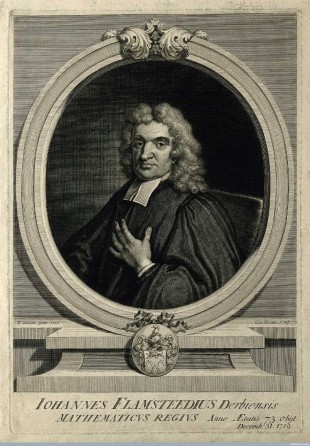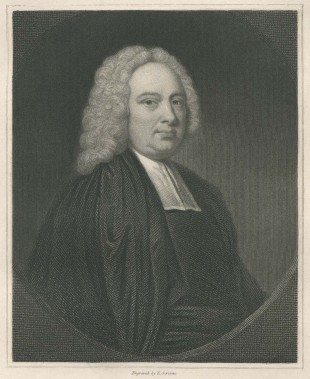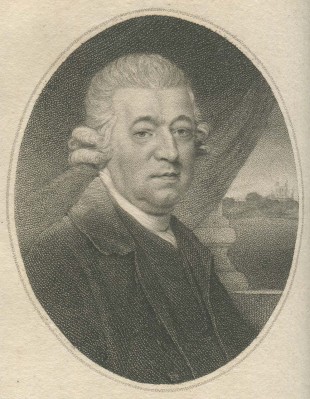…where east meets west
- Home
- Brief History
- The Greenwich Meridian
- Greenwich
(1675–1958) - Herstmonceux
(1948–1990) - Cambridge
(1990–1998) - Outstations (1822–1971)…
- – Chingford (1822–1924)
- – Deal
(1864–1927) - – Abinger
(1923–1957) - – Bristol & Bradford on Avon
(1939–1948) - – Bath
(1939–1949) - – Hartland
(1955–1967) - – Cape of Good Hope
(1959–1971)
- Administration…
- – Funding
- – Governance
- – Inventories
- – Pay
- – Regulations
- – Royal Warrants
- Contemporary Accounts
- People
- Publications
- Science
- Technology
- Telescopes
- Chronometers
- Clocks & Time
- Board of Longitude
- Libraries & Archives
- Visit
- Search
The Head of the Observatory – the Astronomer Royal / Director
From its founding in 1675 until 1972, the Observatory was headed by the Astronomer Royal. From 1972 until its closure in 1998, it was headed by a Director.
Background

John Flamsteed, the First Astronomer Royal. Line engraving by G. Vertue, 1721, after T. Gibson, 1712. Copyrighted work reproduced courtesy of Wellcome Library, London under the terms of a Creative Commons Attribution only licence CC BY 4.0 (see below)

Edmond Halley, the second Astronomer Royal in about 1736. Engraving by William Thomas Fry from an original picture ascribed to Dahl in the possession of the Royal Society. From Portraits of Eminent Men, Society for the Diffusion of Useful Knowledge, C Knight, London (1845)

James Bradley, the third Astronomer Royal. Engraved by E. Scriven from an original painting by Thomas Hudson in the possession of the Royal Society and published in The Gallery of Portraits with Memoirs (Society for the Diffusion of Useful Knowledge), volume VI, p.69 (1836)

Nevil Maskelyne, the fifth Astronomer Royal. Engraved from a pastel drawing by John Russell and published by J. Asperne, 1 March 1804

George Airy, the seventh Astronomer Royal. Woodburytype by Lock & Whitfield. From Men of Mark, Volume 2, London (1877)
The newly formed Science Research Council, which took over the Observatory’s funding in 1965, decided that when the then Astronomer Royal, Woolley retired, the Observatory would be run by a Director, who might or might not also be awarded the title of Astronomer Royal. Since 1972, the position of Astronomer Royal has been largely honorary, appointments being made by the Sovereign upon the advice of the Prime Minister. The Astronomer Royal receives a nominal stipend of £100 a year and is a member of the Royal Household.
After 1971, no Astronomer Royal ever held the post of Director of the Observatory at the same time. The specific post of ‘Director, Royal Greenwich Observatory’ ceased to exist after the re-organization of March 1993 when Boksenberg, the then Director, was appointed to the new post of ‘Director Royal Observatories’ (Royal Greenwich Observatory Cambridge, Royal Observatory Edinburgh, Isaac Newton group of Optical Telescopes Canary Islands, Joint Astronomy Centre Hawaii (UK dir Gemini Telescopes Project)). In 1995 the merged observatories were turned back into four independent entities and the post: ‘Director, Royal Greenwich Observatory’ reinstated.
For the sake of clarity, the pre 1972 Astronomers Royal were sometimes referred to as the Director of the Observatory. An example can be found in the Proceedings of the Observatories which were published annually in the Monthly Notices of the Royal Astronomical Society. There, the term Director in conjunction with the Royal Observatory Greenwich started to be used in 1905. Another example is in the 1971/72 Science Research Council annual report, where for that particular year only, Woolley is listed as ‘Astronomer Royal and Director’.
The post of Astronomer Royal was originally a post for life. The first five Astronomers Royal all died in Office. The sixth (Pond) was the first to retire. The seventh (Airy) retired at the age of 80, whilst the eighth, ninth and tenth all retired around the age of 65. The announcement in July 1971 that after the retirement of Woolley (the eleventh Astronomer Royal), that the title of Astronomer Royal would no longer go automatically to the Director of the RGO together with the appointment of Burbidge as the new Director while Woolley was still in office, left open the possibility of Woolley continuing to lay claim to the title – something that he was to subsequently make a joke of in an interview in The Guardian on 13 November 1971. When Woolley ceased to have responsibility for the Observatory at the end of 1971, whether or not he had also ceased to hold the post of Astronomer Royal remained ambiguous. In an attempt to resolve this once and for all, on 16 May 1972, a letter was sent to him from Downing Street to let him know that it was the intention of the Queen to shortly appoint a new Astronomer Royal and to convey her gratitude for his distinguished service during the years in which he held this office. In effect, he was being put on notice that his tenure as Astronomer Royal was about to be terminated. This done, the Prime Minister wrote to Martin Ryle on 25 May, asking if he would be happy for his name to be put to the Queen as Woolley’s successor. Ryle agreed and the matter was put to the Queen who approved the appointment. An announcement to this effect was made from Downing Street on 27 June. Since 1972, the Astronomers Royal have no longer been obliged to resign the post at the age of 65. Ryle was informed by the Prime Minister at the time of his appointment merely that he would be expected to resign if he were to accept an appointment abroad of if he retired from active professional life. It is presumed that something similar was conveyed to the later incumbents.
Astronomers Royal (as Head of the Observatory) 1675–1971
1675–1719 John Flamsteed
1720–1742 Edmond Halley
1742–1762 James Bradley
1762–1764 Nathaniel Bliss
1765–1811 Nevil Maskelyne
1811–1835 John Pond
1835–1881 George Airy
1881–1910 William Christie
1910–1933 Frank Dyson
1933–1955 Harold Spencer Jones
1956–1971 Richard van der Riet Woolley
Burial places of the first nine Astronomers Royal
Directors (as Head of the Observatory) 1971–1998
1972–1973 Margaret Burbidge*
1973–1975 Alan Hunter
1976–1981 Francis Graham Smith
1981–1995 Alexander (Alec) Boksenberg
1995–1998 Jasper Wall
* Alan Hunter was Acting Director from 1 January to 11 July 1972.
Astronomers Royal (honorary post, not connected to Observatory) 1972–present
1972–1982 Martin Ryle
1982–1990 Francis Graham Smith
1991–1995 Arnold Wolfendale
1995–present Martin Rees
Image licensing information
The 1721 image of John Flamsteed is reproduced in compressed form and at a reduced size under the terms of a Creative Commons Attribution only licence CC BY 4.0 courtesy of Wellcome Library, London
© 2014 – 2025 Graham Dolan
Except where indicated, all text and images are the copyright of Graham Dolan